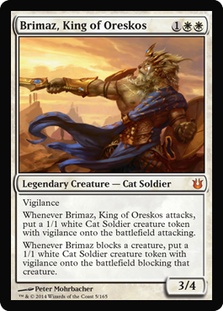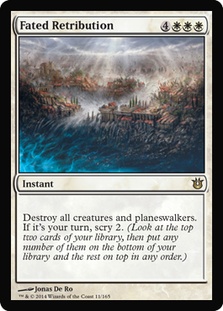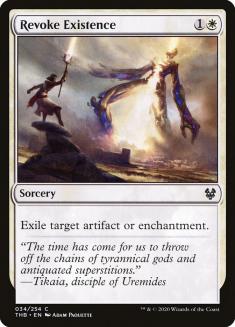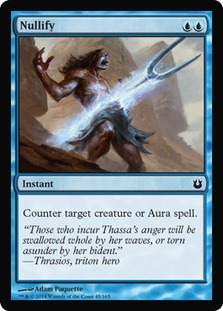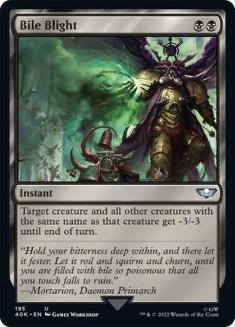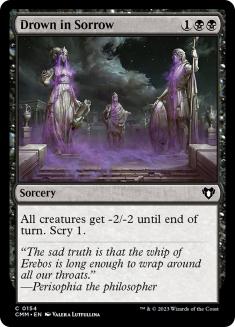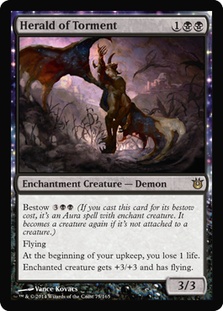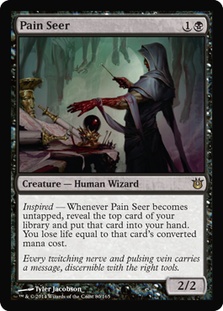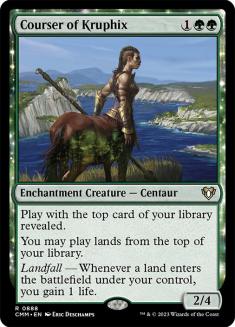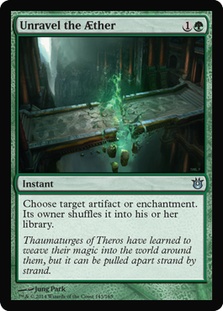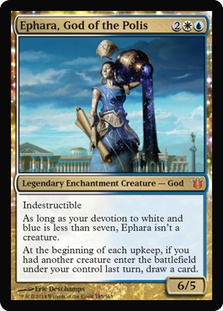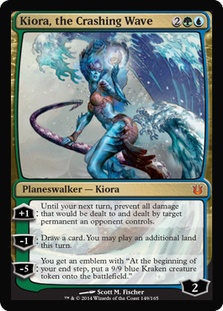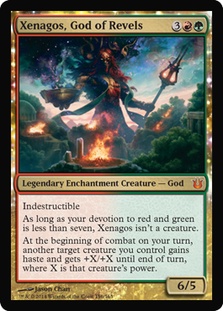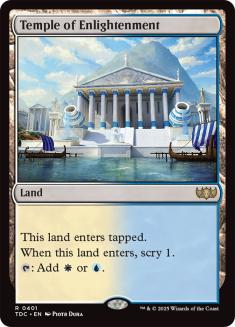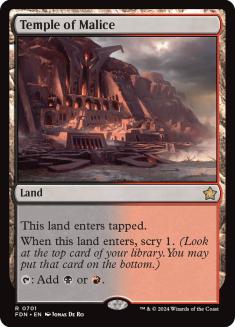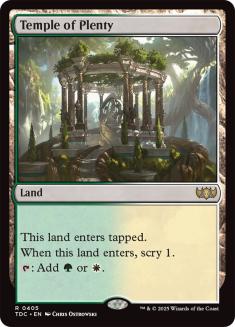Day one.
Literal day one.
What exactly were you expecting? The cards are legal 24 hours, and already the format is much more diverse and the balance of power appears to have shifted.
The first major Born of the Gods Standard tournament was won by a Mono-Blue Devotion deck featuring zero Born of the Gods cards. The Top 4 major archetypes of the weekend were the exact same ones from the previous format.
Of course, there is more to the story. The first day of a new set is typically dominated by the previous format’s strategies. No one has had time to test the new format, and many players don’t even own new cards yet. To really understand the impact of the new set, we need to look a little deeper than a mere headline, a mere caption.
Let’s take a look at this past weekend’s SCG Standard Open in Nashville, Tennessee. To start with, here is a breakdown of all of the decks in the Top 32 of the 511-player event weighted by finish.
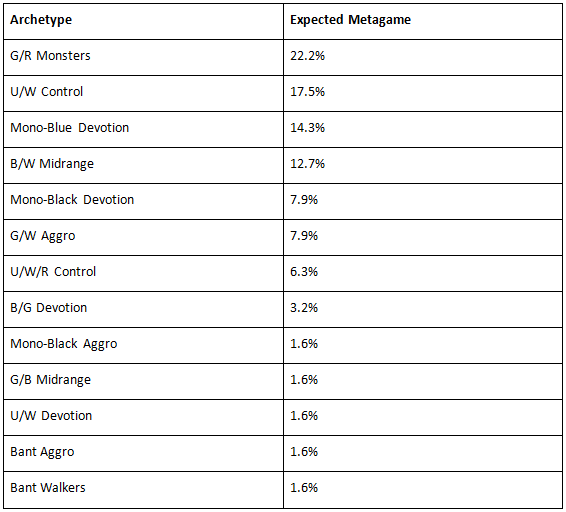
Thirteen different decks? That’s great! Right? G/R Monsters is #1? That’s also great, right? After all, that was the fourth most popular deck last format. Its newfound success is surely because of the sweet new cards it gained, Xenagos, God of Revels and Courser of Kruphix!
Of course, this chart considers B/W Midrange, Mono-Black Devotion, and B/G Devotion to be different decks. What does it look like if we merge all of the like archetypes and only look at the macro archetypes? And how does that compare to the previous format?
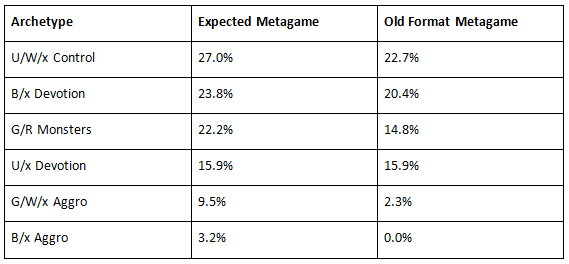
I see.
Even for week one of a new format that is a pretty shockingly unchanged metagame. Yes, G/R is 50% more popular and G/W/x had a good weekend, but for the most part this is basically the exact same format. The only relevant newcomer was B/x Aggro, such as Mono-Black Aggro and B/G Aggro, but it’s possible we should consider the W/B Aggro decks from the previous format as B/x Aggro (which would mean little change to these numbers as well).
Does this mean three months of boring Standard? Is Born of the Gods dead on arrival? Not hardly. This really is week one. Nobody knows what they’re doing with the new cards yet. What it does mean however is that there is great opportunity for those that are first to figure out how to make the most of Born of the Gods.
Let’s take a look at each of these archetypes and see exactly what Born of the Gods cards have shown up already. Additionally, we should look for opportunities present because of Born of the Gods. What cards are people not using yet but could or should? What Born of the Gods cards will benefit from the ways people are currently building their decks?
Let’s start with both the old format’s and the new format’s biggest macro archetype: U/W/x Control. While the overall percentages haven’t changed much, there has actually been far more serious upheaval to this archetype than one might guess from the comparison numbers alone.
U/W/x Control gained Temple of Enlightenment among other cards, a far more important event than most are giving credit to. See, the old format involved basically two types of U/W/x: U/W and Esper. Esper was the only three-color U/W/x combination to have two Temples, unlike U/W/R and Bant. Was that the real reason that U/W/R and Bant did not achieve the same level of success as Esper?
This is just one weekend, but so far not a single Esper deck has shown up and both U/W/R and Bant have finishes (though straight U/W is still the most popular). Let’s start with those two and see what if anything propelled them up besides Temple of Enlightenment. Are they just freak occurrences, the result of people just wanting to experiment? Or are they the beginning of new trends?
Up first is the highest-finishing U/W/x Control deck, Chris Yarbrough’s U/W/R Control in fourth place.
Creatures (1)
Planeswalkers (5)
Lands (20)
Spells (34)

Being able to replace four Azorius Guildgates with four Temples of Enlightenment is a big improvement, but Chris uses quite a few other Born of the Gods cards.
As expected, Fated Retribution is added as a one-of, adding a powerful new dimension to the deck. It’s an excellent card, and it would be great to be able to use more. But it’s hard since it costs so much. Chris does have one fewer Elspeth than many U/W decks, but he also has two Assemble the Legions so he’s actually higher on victory conditions than most.
Fated Retribution is many things:
- A fifth Supreme Verdict
- A fifth answer to planeswalkers
- A major trump to haste creatures
- The ultimate safety card to hold to make sure everything is under control
In addition to Fated Retribution, Chris is among the first adopters of maindeck enchantment removal. Xenagos, God of Revels; Ephara, God of the Polis; Courser of Kruphix; Spirit of the Labyrinth; Herald of Torment; and more on top of Thassa, God of the Sea; Bident of Thassa; Detention Sphere; and Underworld Connections add up to basically everyone having maindeck enchantments. Combine that with the printing of both Revoke Existence and Unravel the Aether and we’re talking about a pretty serious paradigm shift.
We’ve been talking about maindeck Revoke Existence for the past month, and frankly this is just the beginning. Eventually people are going to play more than the miser’s copy.
Finally, Chris has access to three copies of Brimaz, King of Oreskos after board. These are in addition to the two Stormbreath Dragons, giving him a lot of deadly threats that can make life much harder for people that pull some of their creature removal after board. Sure, people are still going to have Hero’s Downfall, but that has plenty of targets anyway. Are they still going to have Devour Flesh? Even if they do, which is doubtful, it gets wrecked by Assemble the Legion and Elspeth. Mizzium Mortars? Almost surely that one gets cut, right?
It’s interesting to me that Chris has a Wear // Tear in the board instead of another Revoke Existence. Is there someone that you’re actually going to regularly hit two cards with it? It’s an instant that costs just one mana, so that’s probably the main factor. I guess if you’re not boarding it in against Gods anyway you might as well use the cheaper version.
Another interesting move is the use of three Renounce the Guilds in the board. Renounce is absolutely awesome against G/R Monsters, hitting Burning-Tree Emissary, Domri Rade, Ghor-Clan Rampager, and both versions of Xenagos. The problem? It also hits your Detention Spheres (and possibly your Assemble the Legion). Of course, if you expect G/R Monsters to board in Destructive Revelry and/or Unravel the Aether (which they will), sideboarding out your six enchantments is actually pretty clever.
The other new U/W/x deck on the block is Brian Braun-Duin’s Bant Walkers. It’s a very different Bant deck than the Reid Duke/Ben Seck Prophet Bant from the last format. Instead it forgoes Sylvan Caryatid, using green for just Kiora, the Crashing Wave (and Mistcutter Hydra out of the board). Beyond that it is just a U/W Control deck same as everyone else.
Planeswalkers (10)
Lands (18)
Spells (32)

Using ten scry lands is a feature, and beyond them we have just two green shock lands as concessions to our green splash. The advantage to such a deck? A lot of raw power, with some pretty serious advantages in the mirror. The downside? Not only does this list use eleven four-drops with no acceleration, but it has just seven spells that can be played before turn 3 and more than half of them are Azorius Charm (which can’t always come down on curve).
In addition to seven new scry lands and Kiora, BBD employs both Brimaz and Revoke Existence out of the sideboard. While the U/W/R list above featured Stormbreath Dragon and Brimaz, BBD has Archangel of Thune, Mistcutter Hydra, and Brimaz. I’m a huge fan of having a variety of powerful victory conditions in the sideboard of control decks that can’t actually take hard control over the game. From the looks of it, that seems to be the name of the game at the moment.
Straight U/W Control is an interesting animal. Percentage-wise it was much more popular at the top tables than U/W/R or Bant; however, not a single copy cracked the Top 8. Was this variance or does U/W struggle with the top decks?
Here’s the highest-finishing U/W Control deck, Adrian Sullivan’s “pure” U/W Elixir of Immortality deck:
Creatures (1)
Planeswalkers (5)
Lands (14)
Spells (40)

Despite four Temples of Enlightenment, The Corruptor doesn’t stop there, employing three more off-color scry lands. They really are quite good in decks without one-drops.
Adrian is well known for his exotic takes on popular archetypes, but this one doesn’t actually stray very far from the beaten path. A maindeck Domestication is noteworthy, as is Disperse. Debtor’s Pulpit is a somewhat unusual choice out of the board, but all in all this is pretty standard fare for Elixir of Immortality builds of U/W.
Perhaps the most interesting elements of Adrian’s list are the cards he did not include. There is no Fated Retribution despite his Elixir of Immortality. There is no Archangel of Thune or Brimaz, with just a single Jace, Memory Adept for post-board victory conditions.
If we want a completely generic baseline U/W Control list to compare these builds to, a good center point of the archetype is Victor Logan’s eleventh-place list:
Creatures (1)
Planeswalkers (7)
Lands (15)
Spells (37)

This is pretty close to the definition of generic U/W Control. No off-color scry lands. Mostly four-ofs, with almost no miser’s cards. A sideboard with Archangel of Thune and Brimaz, King of Oreskos. A single maindeck Negate is the only spice in the entire list. This is a list with no heart and no soul—just cold hard results.
What does Born of the Gods mean for control? Temple of Enlightenment opens up a lot more possibilities than previously existed. Brimaz, Fated Retribution, and Revoke Existence are all fine options. The real question is going to be this: which other decks ascend and which other decks decline? More G/R Monsters is good news for U/W, which has traditionally preyed upon such decks. What other changes are going to shift the playing field?
For instance, what is the fate of B/x control decks? Will there be less Underworld Connections running around? Let’s take a look at black decks, the second most popular macro archetype of both the new and old formats.
While Mono-Black Devotion has generally been the most popular breed of black control decks, B/W Midrange was the winner of week one of the new format, putting two copies into the Top 8. First, we have third-place finisher Dylan Harris:
Creatures (14)
Planeswalkers (2)
Lands (24)
Spells (20)
- 1 Plains
- 4 Thoughtseize
- 3 Underworld Connections
- 1 Ultimate Price
- 3 Devour Flesh
- 4 Hero's Downfall
- 1 Whip of Erebos
- 3 Bile Blight
Sideboard

The only Born of the Gods card Dylan uses are the three Bile Blights, though they are pretty high impact. More interestingly, Dylan has gone several steps beyond the norm with his quantity of big power cards. The full four Blood Barons, four Desecration Demons, two Obzedats, two Elspeths, and a Whip of Erebos is a truck ton of bombs.
It kind of blows my mind to play thirteen expensive bombs with just 25 lands, but adding a 26th land is easy enough (and low risk given our four Mutavaults to help avoid flood).
Dylan is completely unafraid of Bile Blight, as evidenced by the playset of Pack Rats. And why not? After all, he isn’t relying on it at all, with many more victory conditions able to get the job done. All he has to do is not walk face first into it when facing black decks and then sideboard the Rats out.
They’re particularly good with this many expensive cards. If you play someone that can’t get rid of the Rat, you can discard all your expensive cards and just ride it to victory. If someone can answer it, that’s one less removal spell for the real threats to come!
Sixth-place finisher Jessie Butler has a bit of a different take on B/W, at least with regard to specific creatures used. At the end of the day, both decks are just Thoughtseize + Underworld Connections + removal + powerful rare bomb victory conditions.
Creatures (14)
Planeswalkers (2)
Lands (26)
Spells (18)

Nightveil Specter is nothing out of the ordinary, though it is interesting to see two Hallowed Fountains to help cast it (instead of more Orzhov Guildgates or perhaps even Temple of Enlightenment).
Alms Beast instead of Desecration Demon is also not that out of the ordinary, though usually I would only make that move if my Whip of Erebos really needed it or I had trouble getting double black. This list has plenty of black mana and no Whips, so I am skeptical. Desecration Demon is just a stronger card.
Here we see Bile Blight making another appearance, though Revoke Existence also pops up to represent Born of the Gods.
Finally, maindeck Ratchet Bomb is kind of interesting. Adrian Sullivan’s U/W list above had a Ratchet Bomb of its own as well, albeit in the sideboard. Is Ratchet Bomb making a comeback?
Of course, straight black devotion decks were also present, with one the Top 8. Here is Cody Howard’s take on Mono-Black Devotion:
Creatures (15)
- 2 Pack Rat
- 4 Desecration Demon
- 4 Nightveil Specter
- 4 Gray Merchant of Asphodel
- 1 Erebos, God of the Dead
Lands (26)
Spells (19)
- 4 Thoughtseize
- 4 Underworld Connections
- 2 Ultimate Price
- 4 Hero's Downfall
- 1 Whip of Erebos
- 4 Bile Blight
Sideboard

Yeah, it really is just straight up the Owen/Rietzl/Sperling/Huey Mono-Black Devotion from a couple months ago, but with Bile Blight in the maindeck (replacing Devour Flesh or Doom Blade) and Drown in Sorrow in the sideboard.
Good. Boring, but good.
Lifebane Zombie was already a reasonably popular sideboard option, but the increase in G/R Monsters and G/W Aggro means the card’s value has gone up even further. Personally, I sure would like to start a black deck’s sideboard with four. The card is gross.
Speaking of G/R Monsters, here is #SCGNASH finalist (and #SCGCOL finalist) Kent Ketter’s take on what is considered by many to be the major archetype that gained the most from Born of the Gods.
Creatures (25)
- 1 Scavenging Ooze
- 4 Ghor-Clan Rampager
- 4 Elvish Mystic
- 4 Polukranos, World Eater
- 3 Sylvan Caryatid
- 4 Stormbreath Dragon
- 1 Xenagos, God of Revels
- 4 Courser of Kruphix
Planeswalkers (7)
Lands (11)
Spells (17)
Sideboard

To start with, Kent employs Courser of Kruphix instead of Boon Satyr. I think this is a big win for the deck, and while some are being hard on the Courser because of it not accelerating you, the card is truly phenomenal in terms of what it gives you for just three mana. Kent uses a fifth scry land to get a little extra value out of his Courser, and Temple of Malice instead of one of the green scry lands is very smart. Not only does having one extra Forest mean more untapped lands for turn 1 Elvish Mystic, but it also means we are more likely to be able to cast our Courser without having to play the scry land first.
Xenagos, God of Revels also shows up as a one-of, though I think I would prefer two. The card’s full power is not yet understood, but I have a feeling it will prove to be quite good. It’s just such a devastating threat both pre and post Supreme Verdict.
Unravel the Aether makes a sideboard appearance, though it is not at all clear if it really is better than Destructive Revelry. The extra damage is nice against U/W Control, but if you want a card that can also hits Gods, Unravel the Aether is obviously the call.
Bow of Nylea is an interesting sideboard card. My guess is that it’s primarily for the life gain against red and other hyperaggressive decks, but it’s also just an underrated way to break a standoff. It’s another planeswalker-like card that doesn’t die to Hero’s Downfall.
Rounding out the big four, we have Mono-Blue Devotion. Like last season, this archetype is generally mono-blue, though one list splashed white for new hotness Ephara, God of the Polis. First, let’s take a look at the baseline, #SCGNASH champion Eric Gray’s list:
Creatures (28)
- 4 Judge's Familiar
- 4 Frostburn Weird
- 4 Cloudfin Raptor
- 4 Nightveil Specter
- 4 Tidebinder Mage
- 4 Thassa, God of the Sea
- 4 Master of Waves
Planeswalkers (2)
Lands (5)
Spells (25)
Sideboard

This is literally the exact generic list people have been using for months. There are no Born of the Gods cards and no crazy new pieces of technology. This deck is still good and still capable of just winning on the merits. Born of the Gods doesn’t really offer a ton to the mono-blue builds of Thassa, though Thassa’s Rebuff warrants consideration.
Michael Majors also cracked the Top 8, and his build of Mono-Blue Devotion is equally uninspired:
Creatures (28)
- 4 Judge's Familiar
- 4 Frostburn Weird
- 4 Cloudfin Raptor
- 4 Nightveil Specter
- 4 Tidebinder Mage
- 4 Thassa, God of the Sea
- 4 Master of Waves
Lands (5)
Spells (27)

This is no knock on Michael or Eric. Their job was to crush the tournament, and they did. I just mean we don’t have a lot new to learn about the format from them beyond that people are not doing their due diligence and actually doing what it takes to beat Mono-Blue Devotion.
The more exotic build of Mono-Blue Devotion to place was Chase Cagle’s U/W Devotion:
Creatures (17)
- 4 Frostburn Weird
- 4 Nightveil Specter
- 3 Thassa, God of the Sea
- 4 Master of Waves
- 2 Ephara, God of the Polis
Planeswalkers (4)
Lands (13)
Spells (27)

This is not merely a couple copies of Ephara and some Detention Spheres in a Mono-Blue Devotion deck. This build features Elspeth, Sun’s Champion; Nullify; Sphinx’s Revelation; and Supreme Verdict for a very legitimate control game that happens to use Frostburn Weird, Nightveil Specter, and Master of Waves instead of Last Breath, Azorius Charm, and Syncopate.
As you can see, Chase uses quite a few Born of the Gods cards. Obviously Ephara, God of the Polis and Temple of Enlightenment are big, but that’s not it. Revoke Existence makes another sideboard appearance—no surprise there. More interestingly, Chase’s three maindeck copies of Nullify are intriguing as two-mana counters that not only hit creatures (including Gods) but also answer Underworld Connections, Chained to the Rocks, Unflinching Courage, Gift of Orzhova, Domestication, and Claustrophobia.
Finally, it should be noted that this is yet another deck with Ratchet Bomb. It’s definitely starting to look like a trend.
What about the archetypes outside of the big four? In the old format, the default fifth best deck was generally considered to be W/x Aggro, which completely fell off this past weekend. Taking its place was the early darling of the previous format: G/W Aggro.
Creatures (24)
- 1 Loxodon Smiter
- 4 Experiment One
- 4 Voice of Resurgence
- 1 Banisher Priest
- 4 Fleecemane Lion
- 4 Boon Satyr
- 4 Soldier of the Pantheon
- 2 Brimaz, King of Oreskos
Planeswalkers (2)
Lands (23)
Spells (11)

G/W Aggro benefits from Born of the Gods in a number of ways. To start with, while it doesn’t love tapped lads, Temple of Plenty is certainly a big upgrade over Selesnya Guildgate.
G/W Aggro may have already been a little glutted at the three spot, but Brimaz is a powerful enough card that even if we have to cut some Loxodon Smiters we are getting a power level boost.
Revoke Existence in the sideboard is obviously fine, but begs the question of which is better, it or Unravel the Aether. My first guess would be that the instant speed of Unravel is worth more than the slight increase in quality of our opponent’s draws from having one more threat in their deck.
Perhaps the biggest win for G/W Aggro however is the decline of Mono-Blue Devotion. Given Thassa’s win this past weekend, it remains to be seen if Mono-Blue Devotion is actually on the decline, but given how little it gains from Born of the Gods it might prove true. Kaleb certainly seems to believe this, using just three protection from blue creatures while some past lists featured six to eight.
Why? Traditionally, Mono-Blue Devotion has been pretty savage toward G/W. It’s not just stuff like Tidebinder Mage. It’s the entire gumming up the board and then winning with Thassa or Master of Waves angle. These G/W decks have very little removal, letting devotion decks build up a critical mass of devotion without much effort.
Of course, at the moment we are seeing exactly as much Mono-Blue Devotion at the top tables as we did the week before Born of the Gods became legal, so maybe the G/W resurgence is a little ahead of its time.
Interestingly, the Open in Nashville featured a new spin on G/W Aggro in the form of a Bant deck that is really just G/W with a splash for Ephara, Detention Sphere, and sideboard cards.
Creatures (21)
- 2 Loxodon Smiter
- 4 Precinct Captain
- 4 Voice of Resurgence
- 1 Heliod, God of the Sun
- 3 Fleecemane Lion
- 3 Ephara, God of the Polis
- 4 Brimaz, King of Oreskos
Lands (19)
Spells (20)

Ryan’s build is set up more like an Ephara deck with a sort of devotion to white angle going on. Brimaz, Spear of Heliod, and Precinct Captain all contribute to symbols to the cause of waking up Ephara and Heliod (which are effectively replacing Advent of the Wurm).
Brave the Elements is not that rare in G/W decks, and not using Advent, Boon Satyr, Elvish Mystic, or Experiment One means that every one of our creatures is affected by it.
Three Spear of Heliods? Isn’t that a lot? Sure, but the Spear has improved a lot with Born of the Gods. It fights Bile Blight and Drown in Sorrow. It hurts the new burn spells people have access to. It makes your Brimaz win the head to head. It even gives us yet another way to actually get Precinct Captain through on turn 3 (for instance, against Sylvan Caryatid).
Ryan has opted for Unravel the Aether instead of Revoke Existence in the sideboard, a move I’m on board with. It’s worth noting just how many of these decks have one or the other in the sideboard. Additionally, he has access to Supreme Verdict after board (not to mention an extra blue mana to help cast it on time). This is a very different element than most G/W Aggro decks. The sideboard Elspeths help us play more of a control game, letting us change the texture of Mono-Blue Devotion battles. We can’t beat them as a G/W deck, so maybe if we transform into more of a control deck . . .
The last macro archetype I want to take a look at today is B/x Aggro. This wasn’t a major archetype in the old format, but Herald of Torment appears to have changed things.
Two different Herald of Torment decks made the Top 32 in Nashville. Let’s start with the basic mono-black approach:
Creatures (28)
- 4 Rakdos Shred-Freak
- 4 Rakdos Cackler
- 4 Lifebane Zombie
- 4 Tormented Hero
- 4 Mogis's Marauder
- 4 Pain Seer
- 4 Herald of Torment
Lands (22)
Spells (10)

This list is set up like a Mono-Red Aggro deck, but with Thoughtseize, Bile Blight, and Hero’s Downfall instead of burn. Tormented Hero and Rakdos Cackler provide the necessary two power for one mana creatures—no surprise there. The two spot however features a new Born of the Gods addition in Pain Seer. Neither Rakdos Shred-Freak nor Pain Seer is exciting, but they get the job done. And frankly, there isn’t a lot of competition.
Lifebane Zombie is no surprise at the three spot, but Mogis’s Marauder is a little less orthodox. If you think about it, though, it’s actually pretty sweet. A 2/2 haste creature for three isn’t that bad, and the ability to make your entire team unblockable (against most opponents) goes a long way toward making up for the lack of reach from no burn spells.
Finally, topping out the curve we have Herald of Torment, the reason this deck exists at all. On its own, Herald of Torment is a three-power threat that’s difficult to block. The life loss means it’s fine, not great. Where the card’s true power comes from is when you bestow it. Boon Satyr’s flash ability is obviously quite fancy, but Herald of Torment giving flying is such a radical departure from what black normally has at a tournament-quality rate.
While a red deck generally can’t afford to play very many Stormbreath Dragons due to the risk of them gumming up your hand early, Herald of Torment has no such risk. Play the full playset, and if you get stuck with one early, just play it as a three-power flier for three.
Is it really fair to compare Herald of Torment to Stormbreath Dragon? Absolutely. Stormbreath Dragon often adds four power to the air out of nowhere, while Herald of Torment adds five or six! There are so many creatures that can potentially lock up the ground that having a five- or six-power threat in the skies out of nowhere can finish the game quickly. It’s not just Lifebane Zombie that does six either. Tormented Hero pings for an extra point the turn you bestow it, and Pain Seer can even get a chance to draw some extra cards that it otherwise wouldn’t be able to from being locked out of combat. That’s a lot of life loss, but against a control deck who cares?
As if five or six points of haste in the air wasn’t enough (and I say haste since the ground creature was presumably brick walled), Herald of Torment also does double duty, giving us serious anti Supreme Verdict insurance. The card is quite strong and well suited to what black aggro actually needs to be able to do to compete in the new world. If Born of the Gods is radically changing the landscape of Standard, this is the first step.
Herald of Torment has created a new major archetype.
Let’s take a look at the other Herald of Torment deck to Top 32 #SCGNASH, Ben Dugan’s B/G Midrange deck:
Creatures (22)
Lands (16)
Spells (22)
Sideboard

This is a much slower midrangey deck that features a lot more removal and relies on Herald of Torment along with Boon Satyr and Dreg Mangler to build a lethal threat when combined with Reaper of the Wilds. That is a lot of extremely durable threats. It tries to play efficient heavy hitters while clearing the way and disrupting the opponent with extremely versatile reactive cards like Thoughtseize, Golgari Charm, Abrupt Decay, and Hero’s Downfall. Even Bile Blight has applications against every opponent, sweeping Elspeth tokens or killing Mutavaults.
This adds up to a ton of removal without having dead cards against anyone and threats that hit hard enough to make each one a threat that must be answered. This approach is so out of the norm for what has been going on in Standard that it’s hard to judge if it will catch on. One thing that is for certain is that it needs to be tested. My experience with this color combination has not given me confidence in its mana base, and Herald of Torment side by side with Boon Satyr doesn’t make things any easier. This is a deck that really needs the B/G Temple that will be in the next set.
So has Born of the Gods made an impact yet? On day one 16 out of its 165 cards cracked the Top 32 of major tournament play:
That is a pretty good mix, and already we have seen a couple new decks. I am cautiously optimistic about Born of the Gods’ ability to shake up the format. This is actually a pretty respectable day one presence, even if the Top 4 decks are the same as last season (so far).
Additionally, Born of the Gods is already changing some of the card choices from previous expansions. How much will change to respond to Herald of Torment? Bile Blight? Revoke Existence and Unravel the Aether? Ephara and Xenagos? Brimaz and Kiora? Only time will tell, but figuring out which cards people will use and which cards are good against them is the mission for the next few weeks.
What is the best Born of the Gods card to not show up yet? This afternoon I take aim to the plains of Spain again where the same insane brains domain over the game remains, the reign of our campaign never wanes . . .
But if you let me know, I will build around that card next week!
Patrick Chapin
“The Innovator”

